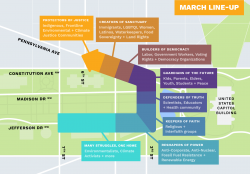May
15
2017

Written by Noelia Mann
At the Climate March last weekend, over 200,000 people took to the streets of DC, again. This time, they gathered in the name of environmental justice. Thoughtful planning ensured that the “Protectors of Justice”- indigenous, frontline environmental, and climate justice communities- led the march, just as they serve as the vanguard of the fight against environmental injustices. Lifting up the leadership of those most deeply affected was as vital to the integrity of the march as it is to this People’s Climate Movement.
The “Creators of Sanctuary” came second-Immigrants, LGBTQI, Women, Latinx, Waterkeepers, and folks working for food sovereignty and land rights. They were followed by the “Builders of Democracy” (Labor, Government Workers, Voting Rights and Democracy Organizations) and the “Guardians of the Future” (Kids, Parents, Elders, Youth, Students and Peace activists). Next, the “Defenders of Truth” (Scientists, Educators, and Health Community), “Keepers of Faith” (Religious and Interfaith groups), and “Re-Shapers of Power” (Anti-corporate, Anti-nuclear, Fossil fuel resistance and Renewable energy). Finally, “Many Struggles, One Home,” comprised of environmentalists, climate activists, and many, many others committed to environmental justice, took up the rear. Unsure of where I belonged, I somehow found myself in that last group, one member of a motley crew carrying a large parachute. Looking around at the group and their various signs and tee shirts, it was clear we all had different on-ramps into this movement for environmental justice, but also that we shared a common commitment to a more equitable planet.
An essential component of that equity is addressing the disproportional impact of environmental injustice on indigenous and low-income communities of color, and that was a major theme of the day. As Congressman Donald M. Payne, Jr. of Newark, NJ, explains “For decades, African-American communities in urban areas have been treated as dumping grounds for pollutants at the expense of community members, the environment, and the economy. The effects are felt every single day.” This type of discrimination is called environmental racism, and its deadly effects are visible in Hurricane Katrina’s devastation of Black communities in New Orleans, in the lead-contaminated water infecting residents of the majority-Black city of Flint, MI, and in the imminent catastrophe accompanying the executive order to move forward with the construction of the Dakota Access Pipeline, to name just a few examples.
In the past 100 days, there has been a lot to protest, and the current administration’s role in perpetuating environmental racism is one among many. But, of course, this phenomenon is nothing new or unique to the Trump administration, and a single march won’t make lasting change. However, as we made our way slowly to the Washington Monument, I watched as our “parachute team” shared water, tapped in replacements when they needed a break, and warned each other of imminent sunburn. It became clear how much we needed to reach across our issue-based silos, our “many struggles,” and work together, not only to hold up this parachute (which was a lot heavier than it looked) but also to hold up this movement and this planet, our “One Home.” When I finally packed up my signs and sunscreen and headed back to New York City, what stood out for me wasn’t the vastness of our task (and it is vast) but the strength and resourcefulness of the movement. The art was unbelievable, the mood was festive and defiant, and the sense of community was vibrant.
This “coming together” was an important opportunity for unity, just as the struggle for environmental justice is a much-needed unifying platform for a diverse #resistance. As we gear up for the long-haul, recharging and feeling the strength of solidarity are more important than ever. Because, in more ways than one, the most important resource in the fight for environmental justice, particularly for low-income communities of color and indigenous peoples, is sustainability.
